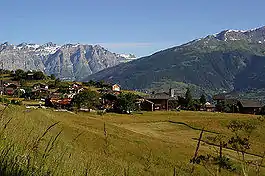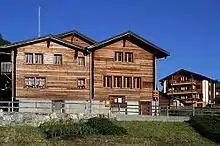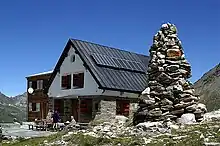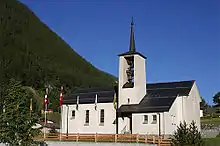Oberems
Oberems is a municipality in the district of Leuk in the canton of Valais in Switzerland.
Oberems | |
|---|---|
 | |
 Coat of arms | |
Location of Oberems | |
 Oberems  Oberems | |
| Coordinates: 46°16′N 7°41′E | |
| Country | Switzerland |
| Canton | Valais |
| District | Leuk |
| Government | |
| • Mayor | Reinhard Zeiter |
| Area | |
| • Total | 84.6 km2 (32.7 sq mi) |
| Elevation | 1,335 m (4,380 ft) |
| Population (31 December 2018)[2] | |
| • Total | 122 |
| • Density | 1.4/km2 (3.7/sq mi) |
| Time zone | UTC+01:00 (Central European Time) |
| • Summer (DST) | UTC+02:00 (Central European Summer Time) |
| Postal code(s) | 3948 |
| SFOS number | 6112 |
| Surrounded by | Agarn, Ayer, Embd, Ergisch, Randa, Saint-Luc, Sankt Niklaus, Unterems |
| Website | www SFSO statistics |
History
Oberems is first mentioned in 1101 as superiori Emesa.[3]
Oberems recorded the highest "Yes" vote of any municipality in Switzerland in the 2021 Swiss same-sex marriage referendum on 26 September 2021; 85.7% of town voters who participated in the referendum voted to legalise same-sex marriage.[4]
Geography

Oberems has an area, as of 2011, of 84.6 square kilometers (32.7 sq mi). Of this area, 15.3% is used for agricultural purposes, while 13.5% is forested. Of the rest of the land, 0.4% is settled (buildings or roads) and 70.8% is unproductive land.[5]
The municipality is located in the Leuk district, on a terrace above the entrance to the Turtmann valley into the Rhone valley. It consists of the villages of Ahorn and Bodmen and several scattered hamlets, such as Gruben/Meiden.
Coat of arms
The blazon of the municipal coat of arms is Per fess Or a Crow displayed Sable between and above two Mullets of Five Argent and Argent from a two-peaked mountain Vert pouring water palewise wavy Azure.[6]
Demographics


Oberems has a population (as of December 2020) of 120.[7] As of 2008, 2.3% of the population are resident foreign nationals.[8] During the 10-year period from 1999 to 2009, the population changed at a rate of 0.8%. It has changed at a rate of 7.5% due to migration and at a rate of 0% due to births and deaths.[5]
All of the population (as of 2000) speaks German.[9]
As of 2008, the gender distribution of the population was 49.3% male and 50.7% female. The population was made up of 63 Swiss men (47.0% of the population) and 3 (2.2%) non-Swiss men. There were 67 Swiss women (50.0%) and 1 (0.7%) non-Swiss woman.[10] Of the population in the municipality, 85 or about 68.0% were born in Oberems and lived there in 2000. There were 23 or 18.4% who were born in the same canton, while 11 or 8.8% were born somewhere else in Switzerland, and 4 or 3.2% were born outside of Switzerland.[9]
The age distribution of the population (as of 2000): Children and teenagers (0–19 years old) make up 24.8% of the population, while adults (20–64 years old) make up 57.6% and seniors (over 64 years old) make up 17.6%.[5]
As of 2000, there were 56 people who were single and never married in the municipality. There were 58 married individuals, 11 widows or widowers and individuals who are divorced.[9]
As of 2000, there were 50 private households in the municipality, with an average of 2.4 persons per household.[5] There were 18 households that consist of only one person and 5 households with five or more people. Out of a total of 52 households that answered this question, 34.6% were households made up of just one person and there was 1 adult who lived with their parents. Of the rest of the households, there are 12 married couples without children, 16 married couples with children. There were 2 single parents with a child or children. There was 1 household that was made up of unrelated people and 2 households that were made up of some sort of institution or another collective housing.[9]
In 2000, there were 96 single-family homes (or 74.4% of the total) out of a total of 129 inhabited buildings. There were 27 multi-family buildings (20.9%), along with 3 multi-purpose buildings that were used mostly for housing (2.3%) and 3 other-use buildings (commercial or industrial) that also had some housing (2.3%).[11]
In 2000, a total of 48 apartments (29.1% of the total) were permanently occupied, while 88 apartments (53.3%) were seasonally occupied and 29 apartments (17.6%) were empty.[11] The vacancy rate for the municipality, in 2010, was 4.24%.[5]
The historical population is given in the following chart:[3][12]

Politics
In the 2007 federal election, the most popular party was the CVP which received 53.71% of the vote. The next three most popular parties were the SVP (24.03%), the SP (17.67%) and the Green Party (3.89%). In the federal election, a total of 44 votes were cast, and the voter turnout was 44.9%.[13]
In the 2009 Conseil d'État/Staatsrat election, a total of 43 votes were cast, of which about 0.0% were invalid. The voter participation was 43.9%, which is much less than the cantonal average of 54.67%.[14] In the 2007 Swiss Council of States election a total of 45 votes were cast, of which about 0.0% were invalid. The voter participation was 46.9%, which is much less than the cantonal average of 59.88%.[15]
Economy
As of 2010, Oberems had an unemployment rate of 0.1%. As of 2008, there were 13 people employed in the primary economic sector and about 7 businesses involved in this sector. 3 people were employed in the secondary sector and there was 1 business in this sector. 19 people were employed in the tertiary sector, with 6 businesses in this sector.[5] There were 52 residents of the municipality who were employed in some capacity, of which females made up 36.5% of the workforce.
In 2008, the total number of full-time equivalent jobs was 26. The number of jobs in the primary sector was 7, all of which were in agriculture. The number of jobs in the secondary sector was 3 of which (0.0%) were in manufacturing The number of jobs in the tertiary sector was 16. In the tertiary sector; 1 was in the sale or repair of motor vehicles, 4 or 25.0% were in the movement and storage of goods, 10 or 62.5% were in a hotel or restaurant, .[16]
In 2000, there were 6 workers who commuted into the municipality and 26 workers who commuted away. The municipality is a net exporter of workers, with about 4.3 workers leaving the municipality for every one entering.[17] Of the working population, 15.4% used public transportation to get to work, and 55.8% used a private car.[5]
Religion

From the 2000 census, 118 or 94.4% were Roman Catholic, while 2 or 1.6% belonged to the Swiss Reformed Church. Of the rest of the population, there was 1 member of an Orthodox church. 2 (or about 1.60% of the population) belonged to no church, are agnostic or atheist, and 2 individuals (or about 1.60% of the population) did not answer the question.[9]
Education
In Oberems, about 44 or (35.2%) of the population have completed non-mandatory upper secondary education, and 8 or (6.4%) have completed additional higher education (either university or a Fachhochschule). Of the 8 who completed tertiary schooling, 62.5% were Swiss men, 12.5% were Swiss women.[9]
As of 2000, there were 7 students in Oberems who came from another municipality, while 10 residents attended schools outside the municipality.[17]
References
- "Arealstatistik Standard - Gemeinden nach 4 Hauptbereichen". Federal Statistical Office. Retrieved 13 January 2019.
- "Ständige Wohnbevölkerung nach Staatsangehörigkeitskategorie Geschlecht und Gemeinde; Provisorische Jahresergebnisse; 2018". Federal Statistical Office. 9 April 2019. Retrieved 11 April 2019.
- Oberems in German, French and Italian in the online Historical Dictionary of Switzerland.
- Marjanović, Petar (27 September 2021). "Diese Gemeinden haben sich in den letzten 16 Jahren am LGBT-freundlichsten entwickelt" (in German). watson.
- Swiss Federal Statistical Office Archived January 5, 2016, at the Wayback Machine accessed 09-September-2011
- Flags of the World.com accessed 09-September-2011
- "Ständige und nichtständige Wohnbevölkerung nach institutionellen Gliederungen, Geburtsort und Staatsangehörigkeit". bfs.admin.ch (in German). Swiss Federal Statistical Office - STAT-TAB. 31 December 2020. Retrieved 21 September 2021.
- Swiss Federal Statistical Office - Superweb database - Gemeinde Statistics 1981-2008 Archived June 28, 2010, at the Wayback Machine (in German) accessed 19 June 2010
- STAT-TAB Datenwürfel für Thema 40.3 - 2000 Archived April 9, 2014, at the Wayback Machine (in German) accessed 2 February 2011
- Ständige Wohnbevolkerung nach Geschlecht und Heimat am 31.12.2009.xls (in German and French) accessed 24 August 2011
- Swiss Federal Statistical Office STAT-TAB - Datenwürfel für Thema 09.2 - Gebäude und Wohnungen Archived September 7, 2014, at the Wayback Machine (in German) accessed 28 January 2011
- Swiss Federal Statistical Office STAT-TAB Bevölkerungsentwicklung nach Region, 1850-2000 Archived September 30, 2014, at the Wayback Machine (in German) accessed 29 January 2011
- Swiss Federal Statistical Office, Nationalratswahlen 2007: Stärke der Parteien und Wahlbeteiligung, nach Gemeinden/Bezirk/Canton Archived May 14, 2015, at the Wayback Machine (in German) accessed 28 May 2010
- Staatsratswahlen vom 1. März 2009 (in German) accessed 24 August 2011
- Ständeratswahl 2007 (in German) accessed 24 August 2011
- Swiss Federal Statistical Office STAT-TAB Betriebszählung: Arbeitsstätten nach Gemeinde und NOGA 2008 (Abschnitte), Sektoren 1-3 Archived December 25, 2014, at the Wayback Machine (in German) accessed 28 January 2011
- Swiss Federal Statistical Office - Statweb (in German) accessed 24 June 2010